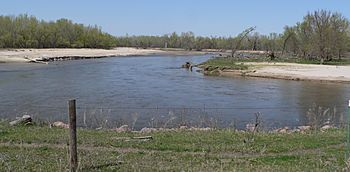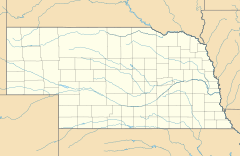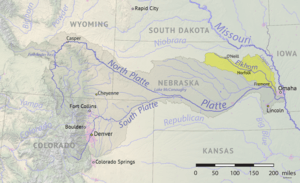Elkhorn River facts for kids
Quick facts for kids Elkhorn River |
|
|---|---|

The Elkhorn River in Antelope County,
April 2010 |
|
|
Location of the mouth of the Elkhorn River in Nebraska
|
|
| Physical characteristics | |
| Main source | Confluence of North Fork and South Fork 2,162 ft (659 m) 42°36′36″N 099°11′00″W / 42.61000°N 99.18333°W |
| River mouth | Confluence with Platte 1,070 ft (330 m) 41°07′12″N 096°18′42″W / 41.12000°N 96.31167°W |
| Length | 290 mi (470 km) |
| Basin features | |
| Progression | Platte—Missouri—Mississippi |
The Elkhorn River is an important river in northeastern Nebraska, United States. It starts in the eastern Sandhills region. The Elkhorn River is one of the biggest tributaries of the Platte River.
This river flows for about 290 miles (467 km). It joins the Platte River southwest of Omaha. This meeting point is near Gretna.
Contents
About the Elkhorn River
The Elkhorn River is found in northeast and north-central Nebraska. Its entire river basin covers about 7,000 square miles (18,000 km²). A river basin is the area of land where all the water drains into that river.
River Branches and Creeks
The Elkhorn River has several smaller rivers and creeks that flow into it. These are called tributaries. Its main branches are the North Fork and South Fork of the Elkhorn. Other important creeks include Logan Creek Dredge, Rock Creek, and Maple Creek.
History of the Elkhorn River
The Lewis and Clark Expedition explored this area a long time ago. They found the Elkhorn River where it meets the Platte River. They called it "Corne de Cerf," which means "Deer's Horn" in French.
Crossing the River
A few miles north of where the two rivers meet is the Elkhorn Crossing Recreation Area. This public park shows where many pioneers camped in the 1800s. These immigrants were traveling west and waited here to cross the river.
For many years, Logan Fontenelle and Joseph LaFlesche helped people cross. They were young men of mixed-race heritage who worked with the Omaha people. They owned the ferry that carried people, wagons, and animals across the river.
Joseph LaFlesche was adopted by the Omaha chief Big Elk. He was chosen to be the next leader. Logan Fontenelle, who was part Omaha and part French, helped the tribe. He worked as an interpreter, helping the Omaha people talk with the U.S. government. He also helped with talks about giving up tribal lands.
See also
 In Spanish: Río Elkhorn para niños
In Spanish: Río Elkhorn para niños



